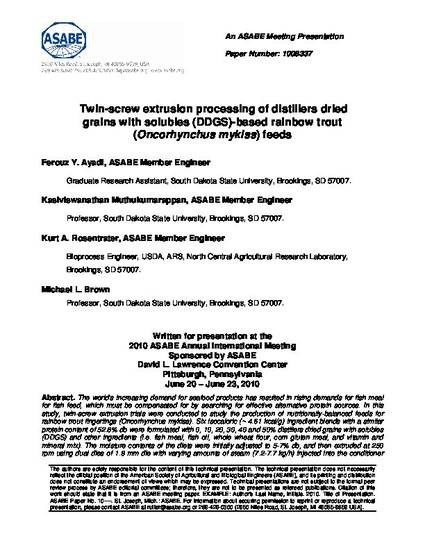
The world’s increasing demand for seafood products has resulted in rising demands for fish meal for fish feed, which must be compensated for by searching for effective alternative protein sources. In this study, twin-screw extrusion trials were conducted to study the production of nutritionally-balanced feeds for rainbow trout fingerlings (Oncorhynchus mykiss). Six isocaloric (~ 4.61 kcal/g) ingredient blends with a similar protein content of 52.8% db were formulated with 0, 10, 20, 30, 40 and 50% distillers dried grains with solubles (DDGS) and other ingredients (i.e. fish meal, fish oil, whole wheat flour, corn gluten meal, and vitamin and mineral mix). The moisture contents of the diets were initially adjusted to 5-7% db, and then extruded at 250 rpm using dual dies of 1.9 mm die with varying amounts of steam (7.2-7.7 kg/h) injected into the conditioner and water (4.3-6.5 kg/h) into the extruder. The mass flow rates, moisture contents, and temperatures were measured during processing. Additionally, moisture content, water activity, unit density, bulk density, expansion ratio, compressive strength, compressive modulus, pellet durability index, water stability, angle of repose, and color were extensively analyzed to quantify the effects of varying DDGS content on the physical properties of the final extrudates. Significant differences (P<0.05) among the blends were observed for color and bulk density for both the raw and extruded materials, respectively, and for the unit density and pellet durability index of the extruded products. There were also significant changes in redness (a) and yellowness (b), but only minor changes in brightness (L), among the final products when increasing the DDGS content of the blends. The compressive strength of the extrudates increased significantly with rising amounts of DDGS. Expansion ratio of all pellets was low. All extruded diets achieved very good water stability. Overall, each of the ingredient blends resulted in viable extrudates.
- Aquaculture,
- DDGS,
- Extrudates,
- Extrusion,
- Physical Properties,
- Protein,
- Twin-screw extruder
Available at: http://works.bepress.com/kurt_rosentrater/123/
